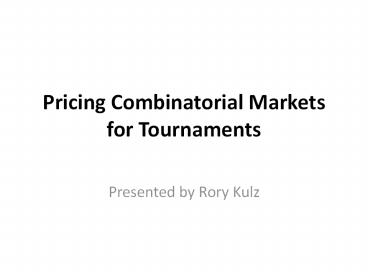Pricing Combinatorial Markets for Tournaments - PowerPoint PPT Presentation
1 / 16
Title:
Pricing Combinatorial Markets for Tournaments
Description:
Pricing Combinatorial Markets for Tournaments Presented by Rory Kulz Main Idea Have seen: Combinatorial markets can offer a wider array of information aggregation ... – PowerPoint PPT presentation
Number of Views:86
Avg rating:3.0/5.0
Title: Pricing Combinatorial Markets for Tournaments
1
Pricing Combinatorial Markets for Tournaments
- Presented by Rory Kulz
2
Main Idea
- Have seen
- Combinatorial markets can offer a wider array of
information aggregation possibilities than
traditional prediction markets. - One way to implement these is with Hansons
logarithmic market scoring rule (LMSR) market
maker, but keeping the requisite distributions
around may (must?) be computationally too hard. - Now
- Look at a restricted case prove feasibility.
3
Outline
- Preliminaries
- P, etc. complexity classes
- Bayesian networks
- Context
- Tournament problem
- Betting languages and results
- Open problems
- Discussion
4
Preliminaries Complexity
- P (Sharp P) is the class of counting problems
associated to decision problems in NP. - 2-SAT
- Given a boolean CNF formula ?, 2 variables per
clause. - Is there a truth assignment that satisfies the
formula? - 2-SAT
- How many assignments exist satisfying the
formula? - NP contained in P.
- Count solutions. Is the count greater than zero?
- Note that 2-SAT is in P, while 2-SAT is
P-complete.
5
Preliminaries Bayesian Networks
- Useful data structure to represent particular
joint probability distributions P(X1, , Xn),
especially where dependencies in the distribution
are sparse. - DAG.
- Each vertex corresponds to one random variable.
- Edges encode conditional (in)dependence.
- Key property P(X1,,Xn) ? P(Xiparents(Xi))
6
Preliminaries Bayesian Networks
- At node representing Xi, store its probability
conditioned on parents. - In general, computing a marginal probability P(Xi
xi) from this is NP-complete. - For certain topologies, however, such as the one
we will encounter, we can do better. - In fact, computing marginal and other conditional
distributions for our topology can be done in
O(n).
7
Context
- Results for LMSR pricing complexity
- Chen et al., 2008. The following are P-hard
- Conjunctions or disjunctions of exactly two
arbitrary events over an event space. - Ranking games with subset/pair betting languages.
- As we saw in Bretts presentation, subset betting
was P in a matching auction, so were not yet
seeing tractability for the LMSR except in toy
cases.
8
Tournaments
- Elimination tournament, n teams.
- So total of n 1 games played, which can be
arranged into a tree structure (think NCAA
brackets). First round teams picked at start,
each subsequent round fed by previous rounds
results. - 2n-1 possible outcomes (left or right child at
each game node).
9
Still a Hard Problem
- Can show that the pricing problem for tournaments
for just monotone boolean 2-CNF formulas (a
conjunction of clauses, each a disjunction of 2
non-negated literals) is still P-hard. - Need to further restrict the betting language,
i.e. the types of bets we can make.
10
Betting Language 1
- Allow bets of the following three forms
- (A) Team i will win game k.
- (B) Team i will win game k, given that they make
- it to that game.
- (C) Team i beats team j, given that they face
off. - How can we get at the pricing complexity?
- General program to show P time find a Bayesian
network that fits the problem.
11
Betting Language 1, Cont.
- Consider Bayesian network arranged like the
tournament tree, with nodes representing the
outcome of each game. - Let edges go in direction opposite causality.
- Show network supports uniform distribution and
updates for bets of type (A). - Show network supports bets that are the
conjunction of two type (A) bets. - Demonstrate how to construct assets (B), (C).
12
Betting Language 1 Complexity
- Can show need to update O(n2) parameters on the
Bayesian network. - Has been shown each update can be accomplished in
linear time for this type of topology. - Hence have complexity O(n3).
- In particular, polynomial time!
13
Introduced Dependencies
- Unfortunately, can show for betting language 1,
certain sequences of bets by players can
introduce dependencies in the distribution where
we would expect none. - Even between the marginal distributions for the
outcomes of distinct first-round games!
14
Betting Language 2
- Restrict to solely bets of type (C).
- Can model using a Bayesian network where edges
flow in a normal causal fashion. - Also can be priced in polynomial time without the
dependency problems of the first betting
language. - For this language though, an update phase is only
O(n).
15
Open Questions
- It seems like bets of type (A) introduce
non-local effects into the distribution that
might be responsible for the weird dependence
behavior what about restricting to, say, bets
(B) and (C)? - Relation to distribution aggregation problem?
- Both betting languages offer access to
polynomially many bets on n. Do there exist
languages or other problems that are
superpolynomial but can still be efficiently
priced? - Fully characterize pricing problems for LMSR?
16
Questions/Discussion































